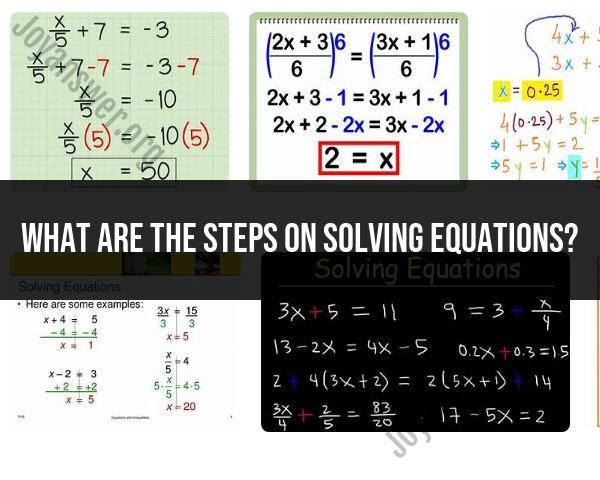What are the steps on solving equations?
Solving equations is a fundamental skill in mathematics, and the process generally involves isolating the variable (typically represented as "x") to find its value. Here are the steps for solving equations:
Write Down the Equation: Start by writing down the equation you need to solve. It can be a linear equation (e.g., 2x + 3 = 7), a quadratic equation, or any other type of equation.
Identify the Variable: Determine which letter represents the variable you want to solve for. In most cases, it's "x," but it can be any other letter.
Simplify the Equation: If there are like terms on both sides of the equation, simplify it by combining these terms. This step is often not necessary for simple linear equations.
Perform Inverse Operations: To isolate the variable, perform inverse operations on both sides of the equation. These are the operations that "undo" what's being done to the variable. The common inverse operations are:
- Addition and subtraction: Add or subtract the same value from both sides.
- Multiplication and division: Multiply or divide by the same nonzero value on both sides.
- Exponents and roots: Apply the opposite operation (e.g., if there's a square root, square both sides).
Simplify Further: After performing inverse operations, the equation may become simpler. Continue simplifying if necessary.
Isolate the Variable: The goal is to have the variable on one side of the equation and the constants on the other side. The equation should look like "x = some number."
Check the Solution: Always check your solution by plugging it back into the original equation. Ensure that both sides of the equation are equal with the value you found.
Here's an example of solving a simple linear equation step by step:
Equation: 2x + 3 = 7
Steps:
- Write Down the Equation: 2x + 3 = 7.
- Identify the Variable: The variable is "x."
- Simplify the Equation: No like terms to simplify.
- Perform Inverse Operations:
- Subtract 3 from both sides: 2x + 3 - 3 = 7 - 3
- This simplifies to 2x = 4.
- Simplify Further: No further simplification needed.
- Isolate the Variable:
- Divide both sides by 2: 2x / 2 = 4 / 2
- This simplifies to x = 2.
- Check the Solution:
- Plug x = 2 back into the original equation: 2(2) + 3 = 7
- 4 + 3 = 7, which is true.
The solution is x = 2, and it checks out when substituted into the original equation.
These steps can be applied to more complex equations as well, and the specific operations and simplifications required will vary depending on the equation's complexity and type. Practice is essential for gaining proficiency in solving equations of different forms.
Here are the answers to your questions about solving equations in mathematics:
What are the fundamental steps for solving equations in mathematics?
The fundamental steps for solving equations in mathematics are:
- Identify the variable. The variable is the unknown quantity that you are trying to solve for.
- Simplify the equation. This means combining like terms and removing any unnecessary parentheses or other symbols.
- Isolate the variable. This means using mathematical operations to get the variable by itself on one side of the equation.
- Solve for the variable. This means performing the necessary operations on the equation to find the value of the variable.
- Check the solution. This means substituting the solution back into the original equation to make sure that it is true.
How to simplify equations and isolate the variable to find a solution?
To simplify equations and isolate the variable to find a solution, you can use the following steps:
- Combine like terms. Like terms are terms that have the same variable and exponent. For example, 2x and 3x are like terms. To combine like terms, simply add the coefficients. For example, 2x + 3x = 5x.
- Remove any unnecessary parentheses or other symbols. For example, if the equation is 2(x + 1) = 5, you can remove the parentheses by multiplying the 2 outside the parentheses by the x and 1 inside the parentheses. This gives you the equation 2x + 2 = 5.
- Isolate the variable. To isolate the variable, you can use mathematical operations such as addition, subtraction, multiplication, and division. For example, if the equation is 2x + 2 = 5, you can subtract 2 from both sides of the equation to get 2x = 3. You can then divide both sides of the equation by 2 to get x = 3/2.
- Solve for the variable. Once you have isolated the variable, you can solve for the variable by performing the necessary operations on the equation. For example, if the equation is x = 3/2, you can simply multiply both sides of the equation by 2 to get x = 3.
What are the common types of equations and methods for solving each type?
There are many different types of equations, but some of the most common include:
- Linear equations: Linear equations are equations that can be written in the form y = mx + b, where m is the slope and b is the y-intercept. Linear equations can be solved by using the following formula: y = mx + b.
- Quadratic equations: Quadratic equations are equations that can be written in the form ax^2 + bx + c = 0, where a, b, and c are constants. Quadratic equations can be solved by using the following formula: x = (-b +/- sqrt(b^2 - 4ac)) / 2a.
- Polynomial equations: Polynomial equations are equations that can be written in the form ax^n + bx^(n-1) + ... + cx^2 + dx + e = 0, where a, b, c, d, and e are constants and n is a positive integer. Polynomial equations can be solved using a variety of methods, such as factoring, graphing, and the quadratic formula.
- Exponential equations: Exponential equations are equations that involve the exponent function. Exponential equations can be solved using a variety of methods, such as factoring, graphing, and logarithmic functions.
- Logarithmic equations: Logarithmic equations are equations that involve the logarithmic function. Logarithmic equations can be solved using a variety of methods, such as factoring, graphing, and exponential functions.
Are there advanced techniques for solving complex equations and systems of equations?
Yes, there are advanced techniques for solving complex equations and systems of equations. Some of these techniques include:
- Factoring: Factoring is a technique for breaking down a polynomial equation into smaller, more manageable equations.
- Graphing: Graphing is a technique for solving equations by plotting the points on a coordinate plane and looking for the intersection points.
- The quadratic formula: The quadratic formula is a formula for solving quadratic equations.
- Logarithms: Logarithms are a mathematical operation that is the inverse of the exponential function. Logarithms can be used to solve a variety of equations, including exponential equations and logarithmic equations.
- Systems of equations: Systems of equations are two or more equations that contain two or more variables. Systems of equations can be solved using a variety of methods, such as substitution, elimination, and Gaussian elimination.
How to check the accuracy and validity of the solutions to equations?
To check the accuracy and validity of the solutions










